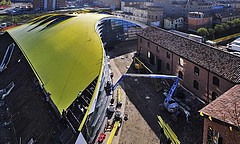
In Modena, the Ferrari museum designed by Kaplický is being ceremoniously opened
 |
| photo: www.autoweek.com |
The ceremonial ribbon-cutting in the brand-new facility near the center is scheduled for Saturday at 5:00 PM, and the first interested visitors will be able to explore the museum for free until nearly midnight. It will be a grand event that the whole city is engaged in, with representatives from the Ferrari company and the foundation that supported the project, as well as politicians, officials, architects, and journalists in attendance. The building, which took three years to complete and cost 18 million euros (about 446 million Czech crowns), will then begin serving the public.
The Future Systems studio has been involved in the project since 2004, when it won a competition against seven other bidders. The jury was impressed by the futuristic design, characterized by distinctive wavy curves and references to Ferrari car designs that are set to be displayed in the museum. The new building is covered with an aluminum roof featuring vents, resembling a giant hood, and is painted in a signal yellow - typical for the emblem of Modena and the car brand with the rearing horse.
Behind the glass facade lies an open exhibition space that aims to highlight individual cars as works of art. In addition, there is also a café, bookstore, research center with an archive and library, a conference hall, and a small cinema. The authors also emphasize that the construction used the most modern technologies and is very environmentally friendly - geothermal energy is used for heating, for example.
Jan Kaplický was involved in the design from the very beginning, and the building bears the typical features of his handwriting - rounded shapes, unusual technical solutions, bold colors, and the use of unconventional materials. These elements were predominantly applied in his most famous works, such as the Selfridges department store in Birmingham or the media pavilion at Lord’s Cricket Ground in London, and indeed in the unrealized project of the National Library in Prague at Letná. Kaplický did not live to see the start of construction in Modena; he died three months before the laying of the foundation stone in January 2009. His colleague from Future Systems, Italian architect Andrea Morgante, who founded his own studio Shiro Studio in 2009, oversaw the realization.
The gallery is one of the two parts of the museum - the other is the reconstructed birthplace of Enzo Ferrari, which will host a permanent multimedia exhibition dedicated to the life of the brand's founder. The automotive racer and designer Ferrari was born in this house, which today stands close to the factory of the competing Maserati brand, in 1898.
Ferrari already has one museum - located within the manufacturing complex in Maranello, not far from Modena. Unlike it, the new museum will not focus solely on cars from one brand but on the strong regional tradition of sports car production. It is intended to be one of the attractions for tourists and lovers of fast machines, who can also visit the production facilities of brands like De Tomaso, Lamborghini, Maserati, Minardi, and Ducati in the surrounding area.
The English translation is powered by AI tool. Switch to Czech to view the original text source.
0 comments
add comment










